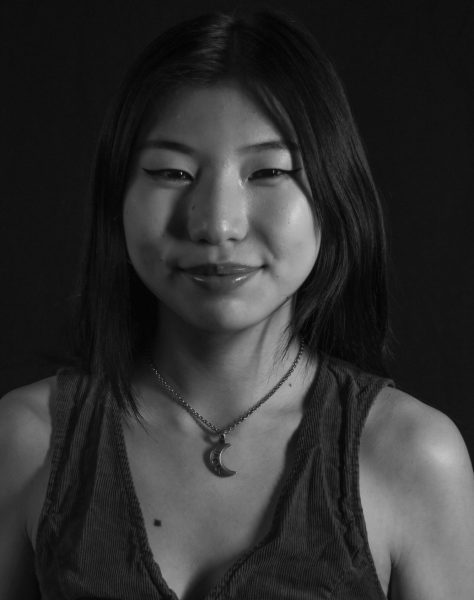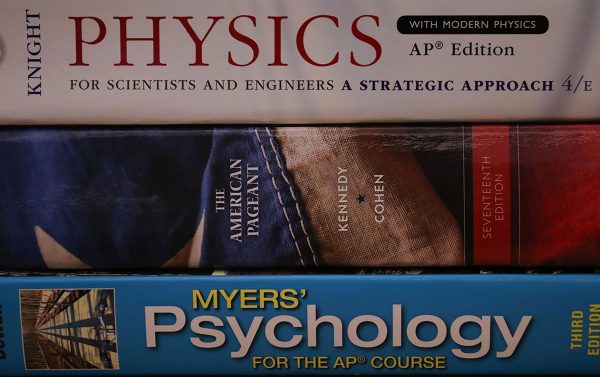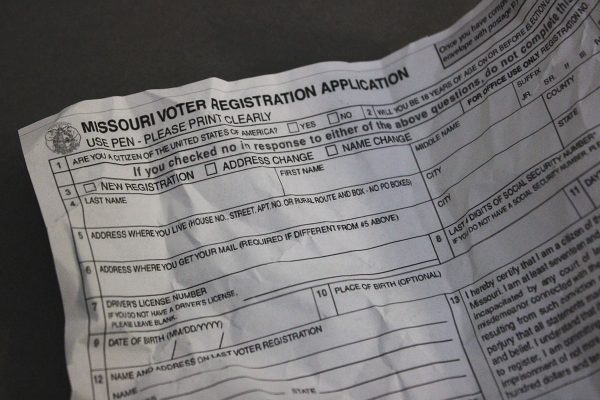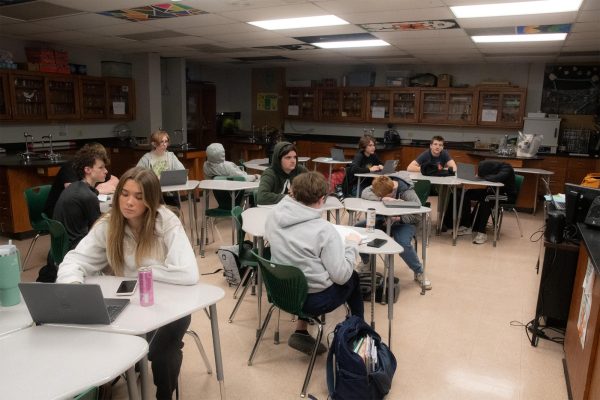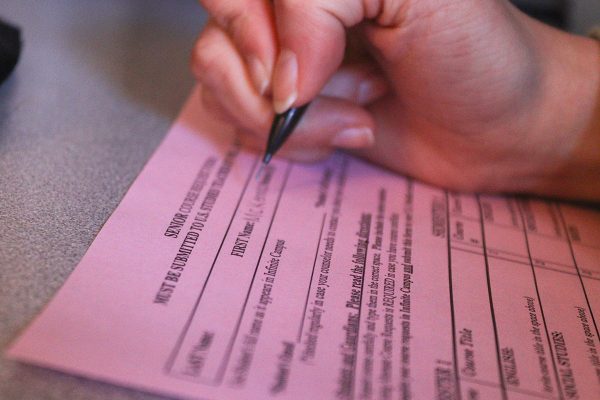The impact of Omicron: variant heightens risk of infection, targets disabled communities
February 2, 2022
Content Warning: Mentions of Ableism
First identified in Botswana and South Africa in November, the Omicron variant of the novel coronavirus has surged around the world over the past two months and now accounts for 99.9% of new infections in the United States, according to the Centers for Disease Control and Prevention (CDC). The pandemic continues to play a recurring role in people’s lives, but Omicron in particular poses new risks toward able-bodied and disabled people in the new year.
Risks of Omicron
Compared to other variants of COVID-19, the major risk with Omicron is its high transmission rate, according to Sara Humm, Boone County Health Department Public Information Specialist. While the variant does call for shorter hospitalization and less need for intensive care, the misconception that it is inherently less life-threatening has greatly endangered people’s health and safety, Humm said. The sheer volume of COVID-19 cases heightens the risk of infection in already vulnerable communities, such as those dealing with health conditions, poverty and housing insecurity, Humm said.
“The biggest risk right now is that there are a large number of cases, which means more people are sick,” Humm said. “While research shows that Omicron is less severe, the number of cases is concerning when considering the number of people who are sick and what that can mean for their overall health. What is a mild case for one person could be a severe case for another person. We also don’t consider that people have to take off work and the economic and personal financial impacts of people being sick.”
The U.S. healthcare system also remains strained under the Omicron surge as hospitals flood with patients seeking care for COVID-19. Dr. Taylor Nelson, Doctor of Infectious Disease and Internal Medicine at the University Hospital with MU Health Care, said staffing shortages have significantly backed-up treatment in the midst of new infections.
“MU Health Care, like most other healthcare facilities, is experiencing an issue with staffing,” Nelson said. “This does not include just doctors, but also nurses, therapists, housekeepers and food services staff. Because of the high transmission of Omicron, lots of staff members have been out with COVID-19 themselves. With increased numbers of patients admitted to the hospital, understaffing has been the biggest issue.”
Long-haul COVID-19
Post-COVID-19 conditions, also known as long-haul COVID-19, are another factor that can pose additional dangers to those infected with Omicron. Long-haul COVID-19 is the persistence of symptoms like fatigue, shortness of breath, chest pain and cough for more than two months after COVID-19 infection, Nelson said. This wide range of health problems can affect anyone whether they experienced mild, moderate or severe symptoms during their recovery period.
Beyond the persistence of COVID-19 symptoms, “the dangers associated with [long-haul COVID-19] can also affect someone’s mental health, including post-traumatic stress disorder, depression, anxiety, as well as some cognitive complaints like difficulty concentrating or ‘brain fog,’” Nelson said.
JIji Wong, Disability Educator at the Xinsheng Project, an organization working to combat right-wing political disinformation on the Chinese social media app WeChat, said long-haul COVID-19 is particularly dangerous to disabled communities, as scientists are finding out that while COVID-19 is a virus that predominantly attacks the lungs, the disease can also weaken the heart in many ways, such as damaging vascular lining and making the blood vessels clog more easily. The risk of vascular disease from the virus means “post-viral complications can be extremely serious down the line, especially to disabled people,” Wong said.
“The disabled community has warned people about post-viral illness, now known as [long-haul COVID-19],” Wong said. “This is a mass disabling experience that will lead to many health complications down the line for at least half of those who have contracted [COVID-19]. Overcoming the initial infection isn’t the end of the battle against [COVID-19]. It’s the start to a lifetime of disability and health risks.”
Testing
Testing has been a vital part of mitigation efforts against COVID-19, but the U.S. is currently facing test shortages in the aftermath of the holiday period that saw millions traveling both domestically and internationally during Omicron. Stores are struggling to keep at-home tests in stock, people are waiting in line for hours at public testing stations and tests are becoming pricier amid the scarcity of supplies. Wong said the commodification of rapid testing in addition to these shortages especially hurts marginalized communities who already face barriers in accessibility. Ableism has enabled people to feel indifferent about disabled people, value us less and allow us to die during the pandemic. The rhetoric that COVID-19 will come and go like a cold leads to recklessness in going out and not masking that not only puts disabled people at risk but non-disabled people as well. — Disability Educator at Xinsheng Project, Jiji Wong
“Health should be a human right—in America, it’s a privilege,” Wong said. “Putting a price tag on anything and pushing it in the capitalist market automatically puts Black, Indigenous, disabled and poor people at risk because they have fewer resources. If the government truly cared about human lives over profit, it would be made free and distributed widely to everyone regardless of their identity, privileges and [positions]. Not every community has a pharmacy that has rapid tests. Not every community member has the transportation or means to buy the tests.”
The Biden administration announced that Americans can begin ordering up to four free at-home COVID-19 rapid tests per household starting Jan. 19, but Wong said the plan still leaves a gap for disabled people of color and those facing housing insecurity.
“This number and the requirement for a home address puts homeless people at a disadvantage and leaves larger households and multigenerational households with fewer tests than needed,” Wong said. “Disabled people of color are even more at risk of housing insecurity which will affect the distribution of testing.”
Starting towards the end of January, local communities in Missouri are taking their own initiative in providing COVID-19 tests in addition to the Biden administration’s plan, Humm said.
“Thanks to MU Health Care and Boone Health, testing is more plentiful in Boone County now than it was a couple of weeks ago,” Humm said. “They both recently opened testing sites that are seven days per week with longer hours. The state of Missouri is also doing drive-thru testing in Columbia one day per week for the next several weeks.”
Ableism during the pandemic
Wong said the pandemic continues to play a prominent role in the disabled community, especially as responses to Omicron are inextricably linked with ableist and eugenist rhetoric.
“Ableism has enabled people to feel indifferent about disabled people, value us less and allow us to die during the pandemic,” Wong said. “The rhetoric that COVID-19 will come and go like a cold leads to recklessness in going out and not masking that not only puts disabled people at risk but non-disabled people as well.”
This frustration is deep-rooted in a lifetime of institutions who feel indifferent about disabled people, especially during health crises, Wong said. On Jan. 7, CDC Director Dr. Rochelle Walensky appeared on Good Morning America and said “The overwhelming number of [COVID-19] deaths, over 75%, occurred in people who had at least four comorbidities, so really these are people who were unwell to begin with…it’s really encouraging news in the context of Omicron.”
While some dismissed the statement as a willful misinterpretation of a study of vaccinated people she was actually referring to, her comments reveal the systemic and institutional biases against disabled people in the medical community that determine their lives as inherently worth less, Wong said.
“It’s clear that our lives are considered lesser and disposable through statements implying that it’s good news that most deaths are disabled,” Wong said. “Professionals, the medical community and politicians have made an outward stance on how disabled people are disposable, so the general population is also less likely to care or take personal responsibility for having compassion for disabled people or to keep us safe. Disabled people will be the first to be abandoned in any health crisis, justified and led by the medical community that is theoretically here to help us.”
Mitigation efforts
The best ways to slow down the spread of the Omicron variant include masking, handwashing, social distancing, avoiding crowding indoors and most importantly vaccinations and booster shots, Nelson said.
“Vaccines are the absolute best way to protect yourself against COVID-19,” Nelson said. “We have a vast amount of research now to show they are safe and effective. With newer variants, complete protection against infection may be somewhat less, but the most important thing is that vaccines continue to protect against severe infection, hospitalization and death. This is especially true after a booster shot. Studies looking at boosters with the Omicron variant show significantly increased protection after this third dose.”
Wong emphasized the importance of masking and social distancing as a means of supporting disabled people during the pandemic and centering them in our mitigation efforts. The disabled community is particularly vulnerable to COVID-19, which makes it critical that people step in to ensure the safety of each and everyone in their communities, Wong said.
“Now is the time to start advocating for disabled voices to be listened to, even though historically we have been ignored and silenced because we aren’t valued,” Wong said. “Ableism is a pandemic that kills. We are quite literally in a pandemic that kills. The best and easiest way to support disabled people at no cost is to avoid going out when not needed and to mask up and social distance when [you] do have to go out. Disabled people cannot afford to get infected, because it will surely leave us more disabled than we were before.”
How has the Omicron variant impacted your life? Let us know in the comments below.
















































































